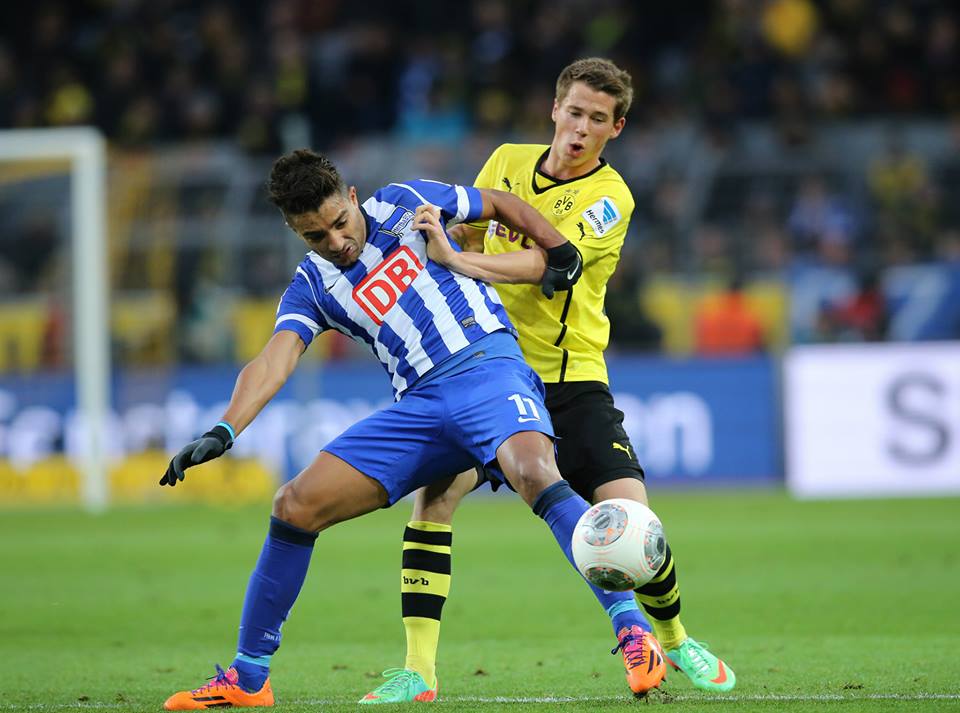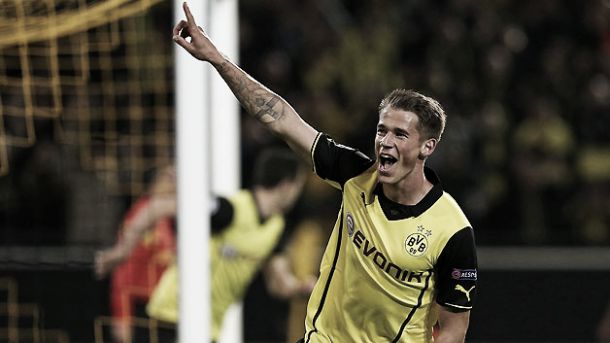Erik Durm is one of the success stories of this season. Originally playing out wide left midfield or as a striker for BVB II, the 21 year old was given a chance to impress during the preseason due to the long term injury lay off to Łukasz Piszczek. A few appearances at right back in friendlies helped Durm cement a place in the senior squad, but it wasn’t until Match Day 5 against Hamburg that he was given a chance in a defensive position.
However, coming on in the 79th minute did not give him a great deal of time to impress. It wasn’t long before his first start came though, as a week later he faced off against Nürnberg. In this game he played at right back, with Kevin Großkreutz moving into the midfield. He had a fairly decent day at the office in a poor game for Dortmund as they drew 1-1. An injury to Marcel Schmelzer in this match forced Klopp’s hand to start young Durm in the following fixtures.
This period would see Durm get a run of five competitive starts in the three different competitions, but this time at left back. The first of the five was making his debut in the DFB Pokal against 1860 München, which went to extra time and eventually ended 2-0 to Dortmund. A Bundesliga game to Freiburg soon followed and here we began to see Durm’s potential. Dortmund ran riot in this game with Freiburg going down to ten men after 45 minutes. The match ended 5-0 with Durm giving a very solid performance in his first full match at left back in the Bundesliga.
The real challenge however was in his next match in the form of Olympique de Marseille in the UEFA Champions League. A loss in the first match against S.C.C Napoli meant Dortmund really needed to kick start their Champions League campaign with a win at home to Marseille. They didn’t disappoint, finishing 3-0 winners. Durm had a fine game by assisting Robert Lewandowski to open the proceedings.
Much praise has to be given to Durm for his patience in waiting for a chance to move into the senior squad. After arriving from Mainz in July 2012 on a costless, he spent the entire 2012/13 season playing for Dortmund’s second string side, Borussia Dortmund II, in the 3. Liga. While playing competitive matches in Germany’s third tier is highly beneficial for a youngster, he was never used in a defensive role.
Flirting with different attacking roles, Durm never really settled or excelled in a particular position. By seasons end the recognition of his key attributes were identified to be suited to the role of a fullback. Klopp commented on this during preseason, identifying Durm’s stamina, pace and determination. Somewhat akin to Großkreutz in a sense, Durm is blessed with the ability to just keep going like an energizer bunny. Coupled with his pace and workrate, he had the key characteristics to work as a foundation to become a fullback.
With further study of the role in regards to positional sense, you just need to look at him in the games against Real Madrid and Bayern München in April to see how far he has come. These two back-to-back games will mark the point that Durm reached a new level, as he nullified any threat from Real Madrid’s Gareth Bale and Bayern’s Arjen Robben. This is when the talk began about a possible inclusion into the national team for the 2014 World Cup, and rightly so.
Klopp recently told WAZ that, “I look forward to any of my boys getting a call-up, but I don't want to fuel any speculation. It doesn't surprise me that he has developed so quickly. He can play left or right, which is a massive strength. We didn't hesitate to play him against Real Madrid and Bayern. He has only started to develop in the fullback position. He is patient enough to work on himself.”
It’s not hard to see that Germany’s biggest weakness could be the fullback positions, particularly the lack of depth. Take away Philipp Lahm and there isn’t a great deal of world-class quality to be seen in these roles. This is a factor that could very well occur as Philipp Lahm has transformed into one of the best midfielders in the league. Germany coach Joachim Löw will be faced with the difficult decision of where to play Lahm. With notable absentees to German’s midfield including İlkay Gündoğan and Sami Khedira, due to long-term injuries, Löw’s hand might be forced. This quickly leads to the real question of who then plays at right back?
Durm’s teammate Kevin Großkreutz looks set to be on the plane to Brazil. His versatility and workrate will prove a vital asset. By covering for Piszczek for the majority of the season, Großkreutz has shown that he is very capable at right back. Having not tested, or even given the chance to Sebastian Jung or Tony Jantschke, Löw needs to seriously consider including Erik Durm in the squad.
As he has been playing for the U21 Germany side recently at right back, he should offer a better option in that role than playing someone out of their position. We have seen the likes of Benedikt Höwedes, Lars Bender or Jérôme Boateng play at right back for Germany and while they are good players, it simply is not ideal.

With Lahm, Großkreutz and Durm covering the right back situation, another issue presents itself, that of left back. Putting it simply, the competition for a spot on the plane for a left back spot for Durm would be his fellow team mate Marcel Schmelzer and Hamburg’s Marcell Jansen. Both fullbacks have struggled this season with injuries and with only a few games left of the season they will have a hard time regaining any form or match sharpness.
The HSV midfielder turned fullback has had an up and down season with Hamburg as they have struggled throughout the majority of the campaign. No one will criticise Jansen’s ability going forward as a fullback, but his real deficiencies lie in defending. While he is a solid tackler, evident in him topping Hamburg’s tackles per game list, he is often caught out of position. This is an area almost every converted fullback struggles with as they work out where to be positionally with the rest of the backline. The balance between attack and defence is key to any fullback and between the three defenders I feel Durm has the advantage.
Despite being similar heights, Durm has won more aerial duels than Schmelzer this season. Most importantly though is the percentage of aerial duels won. Durm comes in at 60%, whereas Schmelzer is 45%. Adding Hamburg’s Marcell Jansen to the list and he sits in-between the two with 56%, despite being much taller. In the tackling department Jansen and Durm currently sit on 52% and 50% respectively.
Schmelzer lags well behind with a mere 38% of attempted tackles being successful. The real draw card between the Dortmund defenders and Marcell Jansen is the foul rate. Despite Jansen and Durm being very close statistically in percentage of tackles competed, Jansen has given away fouls nearly three times more than that of either of the Dortmund players. This would mainly be down to the amount of tackles Jansen has attempted this season in the relegation battle he has found himself in at Hamburg.
Another area that Durm leads in is the ‘take ons’, meaning the number of times he has successfully got past an opposition player. This is an important attribute for fullbacks, both defensively and offensively. Defensively it can often mean the difference between playing out of defence or wasting possession with a clearance. An example of this would be during the Bayern München game in April where Durm made a mockery of Robben and Co. by playing himself out of situations to then easily lay it off to one of the more creative players.
Statistically Durm leads the line with 71% successful take ons. Jansen and Schmelzer lag behind with 64% and 50% respectively. Next we have interceptions per game and yet again Durm leads the line averaging 2.2, with Schmelzer and Jansen tying with 1.7. While it can often be due to a poor pass from the opposition, regular interceptions can be a good sign of a player’s anticipation and defensive intelligence.
Finally we have the clearances per game. This result could be considered rather skewed in comparison of Dortmund and Hamburg players, as the latter has had more to deal with defensively. That aside each player has performed well with Jansen leading the way on 3.8, Durm 3.2 and Schmelzer 2.5.
In an attacking sense the result are somewhat split. Schmelzer and Jansen come up trumps with the most goal scoring opportunities both averaging over one per game. Durm is someway behind with almost half of that; averaging just 0.4 key passes per game. Their attacking prowess is further evident in the assists tally with both Schmelzer and Jansen on 3 each in the league.
However, there’s no need to fret, Durm certainly can hold his own as seen in the Champions League. We have seen glimpses of his attacking talent, which would have been helped by playing further forward for BVB II last season. The fact of the matter is it seems that Erik Durm is doing something not many converted fullbacks do, especially in other leagues. Most feel, along with their coach/manager, that just because they were a winger then they should be given costless license down the flank.
It has become common practice to label these fullbacks defensively poor and suggest that they will pick up the defensive side of the game later down the track, yet they rarely do. Durm seems to be doing the opposite. He has worked rigorously on the defensive side of the game, which is obvious statically and upon viewing, and makes him the better defender of the three. There, I said it. Erik Durm is already a better defender than Marcel Schmelzer and Marcell Jansen.

All these stats are fine to compare players, but at the end of the day they only offer a mere representation of the players quality and form. For instance stats are rarely taken on how often a fullback creates a passing option by making space or helps stretch the opposition defence. These are vital modern day duties of the fullback’s general play due to more teams using inverted wingers/inside forwards.
In conclusion, Jürgen Klopp can feel comforted in the knowledge that he is well covered at left back now, in a position that was looking rather weak last season. Erik Durm has improved so much in only 10 months that he could already be considered Dortmund’s starting left back. In regards to going to the 2014 World Cup, then I think he’s currently the best in-form left back German have, as Schmelzer and Jansen continue to struggle to regain fitness in an injury plagued season.
Of all the coaches to impress, Löw is the one who will be most set in his ways. Durm has done all he can to prove to him by playing more than Schmelzer in the Bundesliga, DFB Pokal and the UEFA Champions League, where he has tested himself against the best. If he continues this development, refines his defensive play and works on his attacking prowess, then he could be the answer Germany has been looking for.
Stats taken from Squawka. Player history from Transfermarkt.










































